Cohen I.M., Kundu P.K. Fluid Mechanics
Подождите немного. Документ загружается.


642 Geophysical Fluid Dynamics
The dispersion relation can be found solely from the first two of these equations; the
third equation then determines the transverse structure. Eliminating ˆu between the
first two, we obtain
ˆη[ω
2
− gH k
2
]=0.
A nontrivial solution is therefore possible only if ω =±k
√
gH, so that the wave
propagates with a nondispersive speed
c =
√
gH. (14.86)
The propagation speed of a Kelvin wave is therefore identical to that of nonrotating
gravity waves. Its dispersion equation is a straight line and is shown in Figure 14.14.
All frequencies are possible.
To determine the transverse structure, eliminate ˆu between the first and third of
equation (14.85), giving
d ˆη
dy
±
f
c
ˆη = 0.
The solution that decays away from the coast is
ˆη = η
0
e
−fy/c
,
where η
0
is the amplitude at the coast. Therefore, the sea surface slope and the velocity
field for a Kelvin wave have the form
η = η
0
e
−fy/c
cos k(x − ct),
u = η
0
g
H
e
−fy/c
cos k(x − ct),
(14.87)
where we have taken the real parts, and have used equation (14.85) in obtaining the
u field.
Equations (14.87) show that the transverse decay scale of the Kelvin wave is
≡
c
f
,
which is called the Rossby radius of deformation. For a deep sea of depth H = 5 km,
and a midlatitude value of f = 10
−4
s
−1
, we obtain c =
√
gH = 220 m/s and
= c/f = 2200 km. Tides are frequently in the form of coastal Kelvin waves of
semidiurnal frequency. The tides are forced by the periodic changes in the gravitational
attraction of the moon and the sun. These waves propagate along the boundaries of
an ocean basin and cause sea level fluctuations at coastal stations.
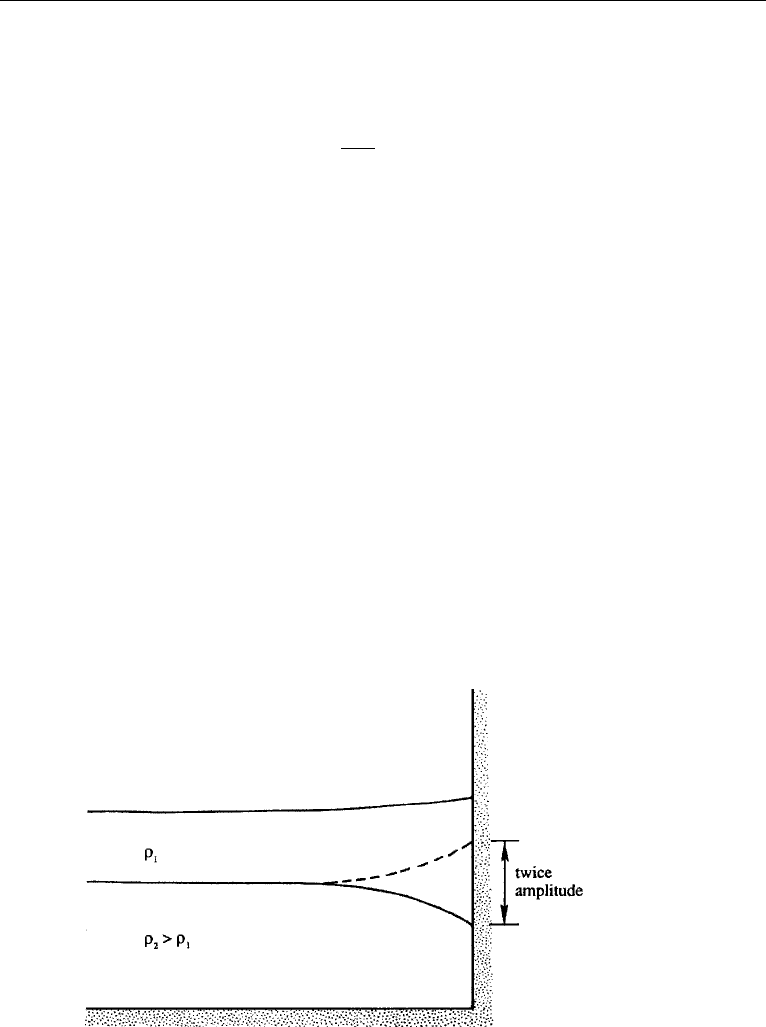
12. Kelvin Wave 643
Analogous to the surface or “external” Kelvin waves discussed in the preceding,
we can have internal Kelvin waves at the interface between two fluids of different
densities (Figure 14.18). If the lower layer is very deep, then the speed of propagation
is given by (see equation (7.126))
c =
g
H,
where H is the thickness of the upper layer and g
= g(ρ
2
− ρ
1
)/ρ
2
is the reduced
gravity. For a continuously stratified medium of depth H and buoyancy frequency N,
internal Kelvin waves can propagate at any of the normal mode speeds
c = NH/nπ, n = 1, 2,....
The decay scale for internal Kelvin waves, = c/f, is called the internal Rossby
radius of deformation, whose value is much smaller than that for the external Rossby
radius of deformation. For n = 1, a typical value in the ocean is = NH /πf
∼ 50 km; a typical atmospheric value is much larger, being of order ∼ 1000 km.
Internal Kelvin waves in the ocean are frequently forced by wind changes near
coastal areas. For example, a southward wind along the west coast of a continent
in the northern hemisphere (say, California) generates an Ekman layer at the ocean
surface, in which the mass flow is away from the coast (to the right of the applied wind
stress). The mass flux in the near-surface layer is compensated by the movement of
deeper water toward the coast, which raises the thermocline. An upward movement of
the thermocline, as indicated by the dashed line in Figure 14.18, is called upwelling.
The vertical movement of the thermocline in the wind-forced region then propagates
poleward along the coast as an internal Kelvin wave.
Figure 14.18 Internal Kelvin wave at an interface. Dashed line indicates position of the interface when
it is at its maximum height. Displacement of the free surface is much smaller than that of the interface and
is oppositely directed.
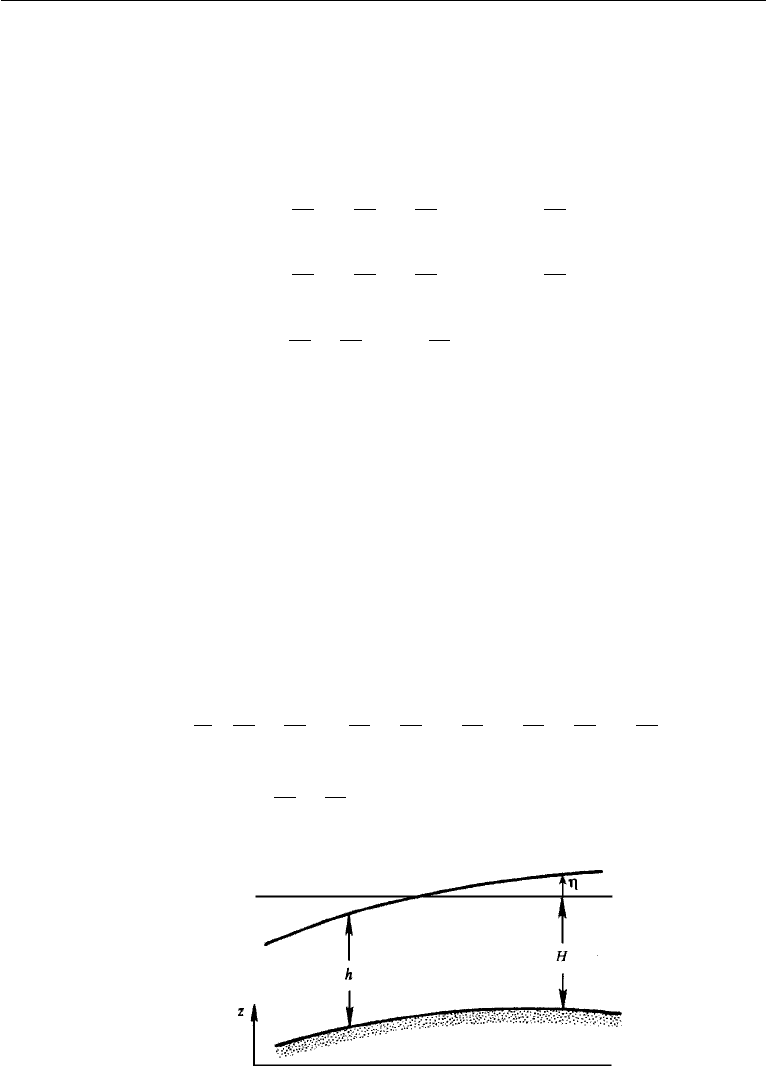
644 Geophysical Fluid Dynamics
13. Potential Vorticity Conservation in
Shallow-Water Theory
In this section we shall derive a useful conservation law for the vorticity of a shal-
low layer of fluid. From Section 8, the equations of motion for a shallow layer of
homogeneous fluid are
∂u
∂t
+ u
∂u
∂x
+ v
∂u
∂y
− fv =−g
∂η
∂x
, (14.88)
∂v
∂t
+ u
∂v
∂x
+ v
∂v
∂y
+ fu =−g
∂η
∂y
, (14.89)
∂h
∂t
+
∂
∂x
(uh) +
∂
∂y
(vh) = 0, (14.90)
where h(x,y,t) is the depth of flow and η is the height of the sea surface measured
from an arbitrary horizontal plane (Figure 14.19). The x-axis is taken eastward and the
y-axis is taken northward, with u and v the corresponding velocity components. The
Coriolis frequency f = f
0
+ βy is regarded as dependent on latitude. The nonlinear
terms have been retained, including those in the continuity equation, which has been
written in the form (14.44); note that h = H + η. We saw in Section 8 that the constant
density of the layer and the hydrostatic pressure distribution make the horizontal
pressure gradient depth-independent, so that only a depth-independent current can be
generated. The vertical velocity is linear in z.
A vorticity equation can be derived by differentiating equation (14.88) with
respect to y, equation (14.89) with respect to x, and subtracting. The pressure is
eliminated, and we obtain
∂
∂t
∂v
∂x
−
∂u
∂y
+
∂
∂x
u
∂v
∂x
+ v
∂v
∂y
−
∂
∂y
u
∂u
∂x
+ v
∂u
∂y
+ f
0
∂u
∂x
+
∂v
∂y
+ βv = 0. (14.91)
Figure 14.19 Shallow layer of instantaneous depth h(x,y,t).
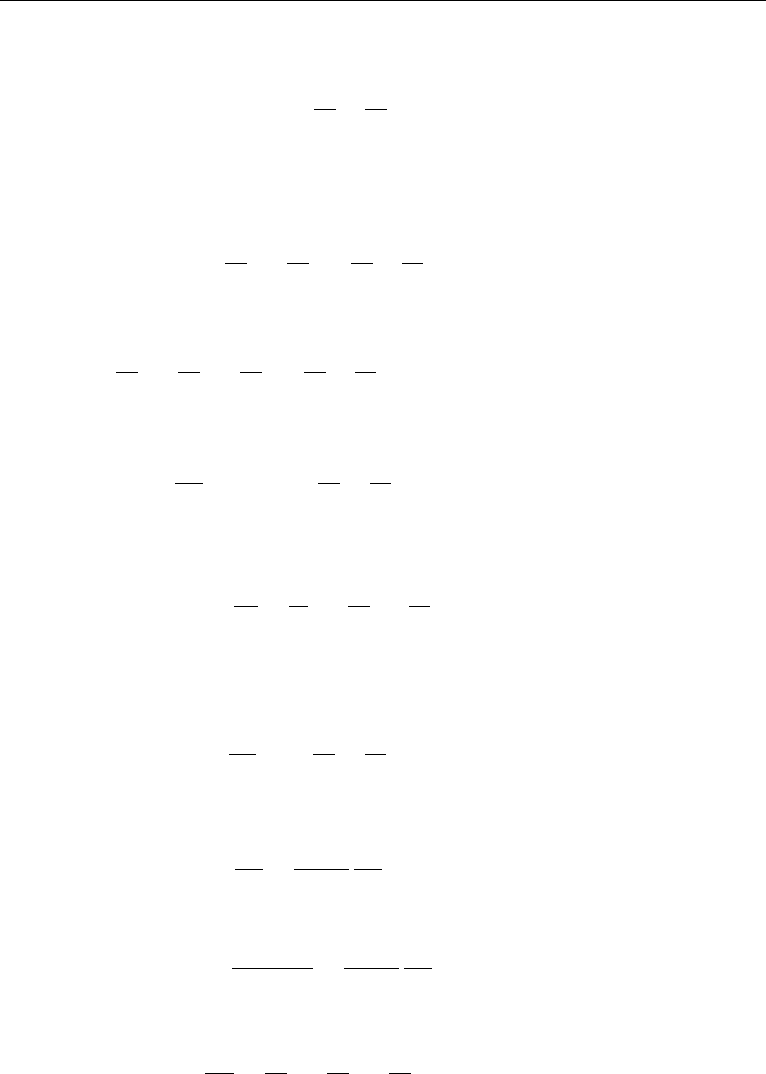
13. Potential Vorticity Conservation in Shallow-Water Theory 645
Following the customary β-plane approximation, we have treated f as constant
(and replaced it by an average value f
0
) except when df/dy appears. We now introduce
ζ ≡
∂v
∂x
−
∂u
∂y
,
as the vertical component of relative vorticity, that is, the vorticity measured relative
to the rotating earth. Then the nonlinear terms in equation (14.91) can easily be
rearranged in the form
u
∂ζ
∂x
+ v
∂ζ
∂y
+
∂u
∂x
+
∂v
∂y
ζ.
Equation (14.91) then becomes
∂ζ
∂t
+ u
∂ζ
∂x
+ v
∂ζ
∂y
+
∂u
∂x
+
∂v
∂y
(ζ + f
0
) + βv = 0,
which can be written as
Dζ
Dt
+ (ζ + f
0
)
∂u
∂x
+
∂v
∂y
+ βv = 0, (14.92)
where D/Dt is the derivative following the horizontal motion of the layer:
D
Dt
≡
∂
∂t
+ u
∂
∂x
+ v
∂
∂y
.
The horizontal divergence (∂u/∂x+∂v/∂y) in equation (14.92) can be eliminated
by using the continuity equation (14.90), which can be written as
Dh
Dt
+ h
∂u
∂x
+
∂v
∂y
= 0.
Equation (14.92) then becomes
Dζ
Dt
=
ζ + f
0
h
Dh
Dt
− βv.
This can be written as
D(ζ + f)
Dt
=
ζ + f
0
h
Dh
Dt
, (14.93)
where we have used
Df
Dt
=
∂f
∂t
+ u
∂f
∂x
+ v
∂f
∂y
= vβ.

646 Geophysical Fluid Dynamics
Because of the absence of vertical shear, the vorticity in a shallow-water model
is purely vertical and independent of depth. The relative vorticity measured with
respect to the rotating earth is ζ , while f is the planetary vorticity, so that the absolute
vorticity is (ζ +f ). Equation (14.93) shows that the rate of change of absolute vorticity
is proportional to the absolute vorticity times the vertical stretching Dh/Dt of the
water column. It is apparent that Dζ /Dt can be nonzero even if ζ = 0 initially. This is
different from a nonrotating flow in which stretching a fluid line changes its vorticity
only if the line has an initial vorticity. (This is why the process was called the vortex
stretching; see Chapter 5, Section 7.) The difference arises because vertical lines in a
rotating earth contain the planetary vorticity even when ζ = 0. Note that the vortex
tilting term, discussed in Chapter 5, Section 7, is absent in the shallow-water theory
because the water moves in the form of vertical columns without ever tilting.
Equation (14.93) can be written in the compact form
D
Dt
ζ + f
h
= 0,
(14.94)
where f = f
0
+βy, and we have assumed βy f
0
. The ratio (ζ +f)/his called the
potential vorticity in shallow-water theory. Equation (14.94) shows that the potential
vorticity is conserved along the motion, an important principle in geophysical fluid
dynamics. In the ocean, outside regions of strong current vorticity such as coastal
boundaries, the magnitude of ζ is much smaller than that of f . In such a case (ζ +f )
has the sign of f . The principle of conservation of potential vorticity means that an
increase in h must make (ζ +f ) more positive in the northern hemisphere and more
negative in the southern hemisphere.
As an example of application of the potential vorticity equation, consider an
eastward flow over a step (at x = 0) running north–south, across which the layer
thickness changes discontinuously from h
0
to h
1
(Figure 14.20). The flow upstream
of the step has a uniform speed U , so that the oncoming stream has no relative vorticity.
To conserve the ratio (ζ + f)/h, the flow must suddenly acquire negative (clockwise)
relative vorticity due to the sudden decrease in layer thickness. The relative vorticity
of a fluid element just after passing the step can be found from
f
h
0
=
ζ + f
h
1
,
giving ζ = f(h
1
− h
0
)/h
0
< 0, where f is evaluated at the upstream latitude of the
streamline. Because of the clockwise vorticity, the fluid starts to move south at x = 0.
The southward movement decreases f , so that ζ must correspondingly increase so
as to keep (f + ζ ) constant. This means that the clockwise curvature of the stream
reduces, and eventually becomes a counterclockwise curvature. In this manner an
eastward flow over a step generates stationary undulatory flow on the downstream
side. In Section 15 we shall see that the stationary oscillation is due to a Rossby wave
generated at the step whose westward phase velocity is canceled by the eastward
current. We shall see that the wavelength is 2π
√
U/β.
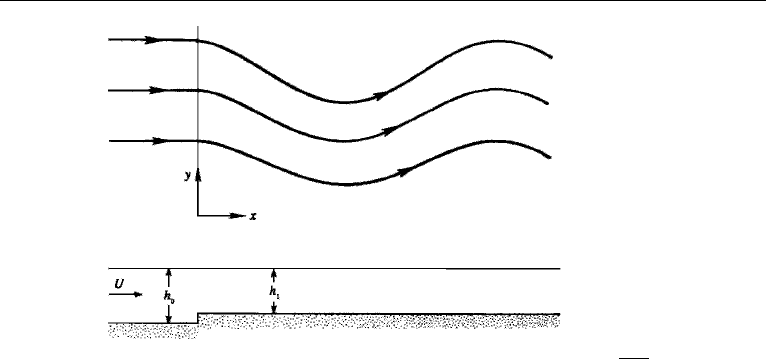
14. Internal Waves 647
Figure 14.20 Eastward flow over a step, resulting in stationary oscillations of wavelength 2π
√
U/β.
Suppose we try the same argument for a westward flow over a step. Then a
particle should suddenly acquire clockwise vorticity as the depth of flow decreases
at x = 0, which would require the particle to move north. It would then come into a
region of larger f , which would require ζ to decrease further. Clearly, an exponential
behavior is predicted, suggesting that the argument is not correct. Unlike an eastward
flow, a westward current feels the upstream influence of the step so that it acquires a
counterclockwise curvature before it encounters the step (Figure 14.21). The positive
vorticity is balanced by a reduction in f , which is consistent with conservation of
potential vorticity. At the location of the step the vorticity decreases suddenly. Finally,
far downstream of the step a fluid particle is again moving westward at its original
latitude. The westward flow over a topography is not oscillatory.
14. Internal Waves
In Chapter 7, Section 19 we studied internal gravity waves unaffected by Cori-
olis forces. We saw that they are not isotropic; in fact the direction of propa-
gation with respect to the vertical determines their frequency. We also saw that
their frequency satisfies the inequality ω N , where N is the buoyancy frequency.
Their phase-velocity vector c and the group-velocity vector c
g
are perpendicular and
have oppositely directed vertical components (Figure 7.32 and Figure 7.34). That is,
phases propagate upward if the groups propagate downward, and vice versa. In this
section we shall study the effect of Coriolis forces on internal waves, assuming that
f is independent of latitude.
Internal waves are ubiquitous in the atmosphere and the ocean. In the lower atmo-
sphere turbulent motions dominate, so that internal wave activity represents a minor
component of the motion. In contrast, the stratosphere contains very little convective
motion because of its stable density distribution, and consequently a great deal of
internal wave activity. They generally propagate upward from the lower atmosphere,
where they are generated. In the ocean they may be as common as the waves on
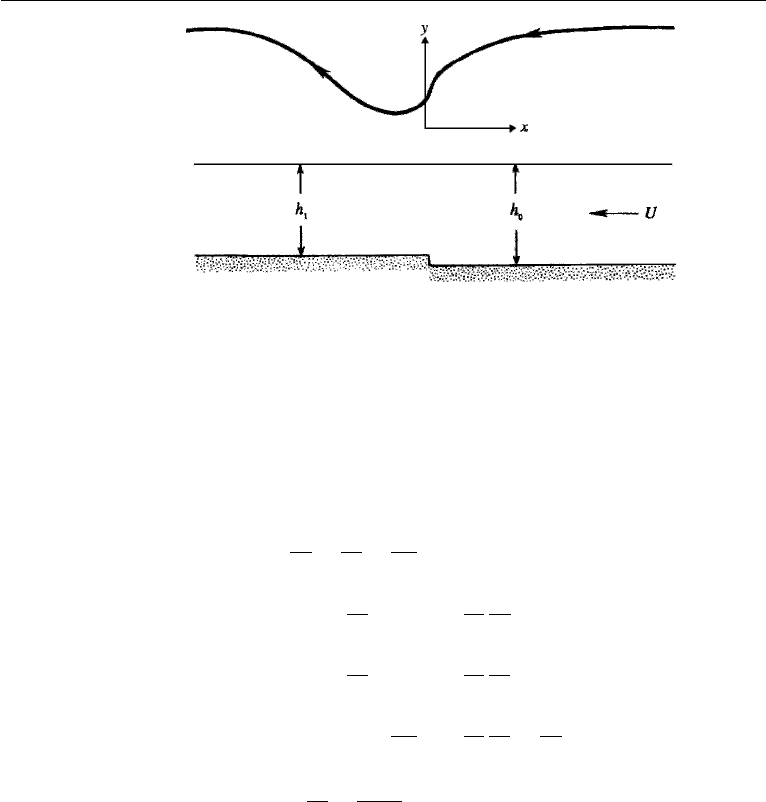
648 Geophysical Fluid Dynamics
Figure 14.21 Westward flow over a step. Unlike the eastward flow, the westward flow is not oscillatory
and feels the upstream influence of the step.
the surface, and measurements show that they can cause the isotherms to go up and
down by as much as 50–100 m. Sometimes the internal waves break and generate
small-scale turbulence, similar to the “foam” generated by breaking waves.
We shall now examine the nature of the fluid motion in internal waves. The
equations of motion are
∂u
∂x
+
∂v
∂y
+
∂w
∂z
= 0,
∂u
∂t
− fv =−
1
ρ
0
∂p
∂x
,
∂v
∂t
+ fu =−
1
ρ
0
∂p
∂y
, (14.95)
∂w
∂t
=−
1
ρ
0
∂p
∂z
−
ρg
ρ
0
,
∂ρ
∂t
−
ρ
0
N
2
g
w = 0.
We have not made the hydrostatic assumption because we are not assuming that the
horizontal wavelength is long compared to the vertical wavelength. The advective
term in the density equation is written in a linearized form w(d ¯ρ/dz) =−ρ
0
N
2
w/g.
Thus the rate of change of density at a point is assumed to be due only to the ver-
tical advection of the background density distribution ¯ρ(z). Because internal wave
activity is more intense in the thermocline where N varies appreciably (Figure 14.2),
we shall be somewhat more general than in Chapter 7 and not assume that N is
depth-independent.
An equation for w can be formed from the set (14.95) by eliminating all other
variables. The algebraic steps of such a procedure are shown in Chapter 7, Section 18
without the Coriolis forces. This gives

14. Internal Waves 649
∂
2
∂t
2
∇
2
w + N
2
∇
2
H
w + f
2
∂
2
w
∂z
2
= 0, (14.96)
where
∇
2
≡
∂
2
∂x
2
+
∂
2
∂y
2
+
∂
2
∂z
2
and
∇
2
H
≡
∂
2
∂x
2
+
∂
2
∂y
2
.
Because the coefficients of equation (14.96) are independent of the horizontal direc-
tions, equation (14.96) can have solutions that are trigonometric in x and y.We
therefore assume a solution of the form
[u, v, w]=[ˆu(z), ˆv(z), ˆw(z)]e
i(kx+ly−ωt)
. (14.97)
Substitution into equation (14.96) gives
(−iω)
2
(ik)
2
+ (il)
2
+
d
2
dz
2
ˆw + N
2
[(ik)
2
+ (il)
2
]ˆw + f
2
d
2
ˆw
dz
2
= 0,
from which we obtain
d
2
ˆw
dz
2
+
(N
2
− ω
2
)(k
2
+ l
2
)
ω
2
− f
2
ˆw = 0. (14.98)
Defining
m
2
(z) ≡
(k
2
+ l
2
)[N
2
(z) − ω
2
]
ω
2
− f
2
, (14.99)
Equation (14.98) becomes
d
2
ˆw
dz
2
+ m
2
ˆw = 0. (14.100)
For m
2
< 0, the solutions of equation (14.100) are exponential in z signifying that
the resulting motion is surface-trapped. It represents a surface wave propagating hor-
izontally. For a positive m
2
, on the other hand, solutions are trigonometric in z, giving
internal waves propagating vertically as well as horizontally. From equation (14.99),
therefore, internal waves are possible only in the frequency range:
f<ω<N,
where we have assumed N>f, as is true for much of the atmosphere and the ocean.

650 Geophysical Fluid Dynamics
WKB Solution
To proceed further, we assume that N(z) is a slowly varying function in that its
fractional change over a vertical wavelength is much less than unity. We are therefore
considering only those internal waves whose vertical wavelength is short compared
to the scale of variation of N .IfH is a characteristic vertical distance over which N
varies appreciably, then we are assuming that
Hm 1.
For such slowly varying N(z), we expect that m(z) given by equation (14.99) is also
a slowly varying function, that is, m(z) changes by a small fraction in a distance 1/m.
Under this assumption the waves locally behave like plane waves, as if m is constant.
This is the so-called WKB approximation (after Wentzel–Kramers–Brillouin), which
applies when the properties of the medium (in this case N ) are slowly varying.
To derive the approximate WKB solution of equation (14.100), we look for a
solution in the form
ˆw = A(z)e
iφ (z)
,
where the phase φ and the (slowly varying) amplitude A are real. (No generality is
lost by assuming A to be real. Suppose it is complex and of the form A =
¯
A exp(iα),
where
¯
A and α are real. Then ˆw =
¯
A exp [i(φ + α)], a form in which (φ + α)isthe
phase.) Substitution into equation (14.100) gives
d
2
A
dz
2
+ A
m
2
−
dφ
dz
2
+ i2
dA
dz
dφ
dz
+ iA
d
2
φ
dz
2
= 0.
Equating the real and imaginary parts, we obtain
d
2
A
dz
2
+ A
m
2
−
dφ
dz
2
= 0, (14.101)
2
dA
dz
dφ
dz
+ A
d
2
φ
dz
2
= 0. (14.102)
In equation (14.101) the term d
2
A/dz
2
is negligible because its ratio with the second
term is
d
2
A/dz
2
Am
2
∼
1
H
2
m
2
1.
Equation (14.101) then becomes approximately
dφ
dz
=±m, (14.103)

14. Internal Waves 651
whose solution is
φ =±
z
mdz,
the lower limit of the integral being arbitrary.
The amplitude is determined by writing equation (14.102) in the form
dA
A
=−
(d
2
φ/dz
2
)dz
2(dφ/dz)
=−
(dm/dz) dz
2m
=−
1
2
dm
m
,
where equation (14.103) has been used. Integrating, we obtain ln A =−
1
2
ln m +
const., that is,
A =
A
0
√
m
,
where A
0
is a constant. The WKB solution of equation (14.100) is therefore
ˆw =
A
0
√
m
e
±i
z
mdz
. (14.104)
Because of neglect of the β-effect, the waves must behave similarly in x and y,
as indicated by the symmetry of the dispersion relation (14.99) in k and l. Therefore,
we lose no generality by orienting the x-axis in the direction of propagation, and
taking
k>0 l = 0 ω>0.
To find u and v in terms of w, use the continuity equation ∂u/∂x + ∂w/∂z = 0,
noting that the y-derivatives are zero because of our setting l = 0. Substituting the
wave solution (14.97) into the continuity equation gives
ik ˆu +
d ˆw
dz
= 0. (14.105)
The z-derivative of ˆw in equation (14.104) can be obtained by treating the denominator
√
m as approximately constant because the variation of ˆw is dominated by the wiggly
behavior of the local plane wave solution. This gives
d ˆw
dz
=
A
0
√
m
(±im)e
±i
z
mdz
=±iA
0
√
me
±i
z
mdz
,
so that equation (14.105) becomes
ˆu =∓
A
0
√
m
k
e
±i
z
mdz
. (14.106)
